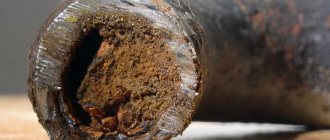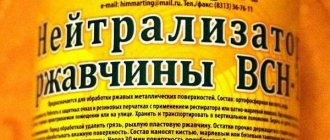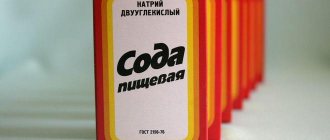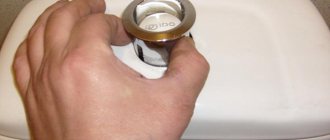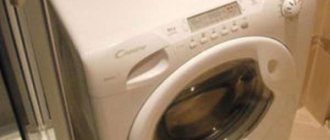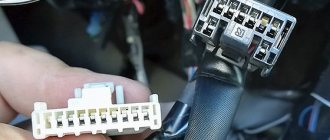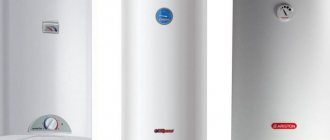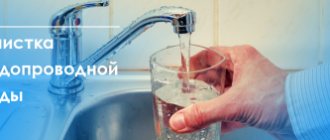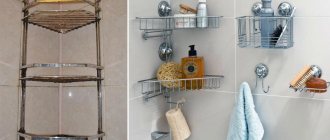Pipes before and after washing with chemicals
A water supply system is a system for the continuous supply of water to consumers, which is necessary for domestic, technical and economic purposes. These are mainly underground pipes or channels. Water purified from mechanical impurities in the filter system is collected in water towers and then distributed through city pipes for water supply.
To avoid the formation of deposits of various salts, chemical flushing of water supply systems is used. The article will tell you how to do this.
If the pipe is still clogged or effective cleaning methods
Pipe cleaning methods depend directly on the material from which the pipe is made.
Steel pipes can be protected. Protection of water pipes from corrosion is carried out by hot-dip galvanizing, as a result of which steel pipes become almost eternal. The only places that can suffer greatly are pipe joints. For all types of pipes used in everyday life, we will try to consider the main methods of cleaning pipelines. Basically, we will talk about mechanical methods.
Steel pipes without internal coating
Steel pipes are the bane of every water supply system. Initially they are rough, and not only are they
They quickly oxidize from oxygen dissolved in water, so they also tend to accumulate mechanical impurities, such as sand and scale. In addition, the slightest fluctuations in the composition of the water, which often occurs because the water is taken directly from rivers, causes powerful salt build-ups inside the pipe, which only worsens the situation. All this adheres to rust, as a result of which the lumen of the pipe can decrease until it becomes completely overgrown.
Protection of water pipes from corrosion is galvanizing, which was mentioned above. It is better to immediately purchase such pipes, but if a special diameter is needed, they can be galvanized. Some companies provide such a service.
In general, it is better to completely get rid of steel in the water supply. Replace steel pipes with analogues made of any other material, fortunately, the choice now allows you to do this.
If the pipe is overgrown, it will gradually lose pressure. This is the surest sign of an impending plumbing collapse in your home. Now is the time to act.
The best and most effective method is to clean water pipes made from steel pipes. It all starts with a complete analysis of the system. Typically, pipes increase in mass by 2-3 times due to the resulting build-up. Disassembly must be done very carefully because this system becomes fragile, especially at the joints
Therefore, if you do not want to go to the welder once again, handle the pipes very carefully
The pipe can be cleaned either with acid or mechanically. For this you need a steel pipe. You can screw something like a small bullet or a ball onto its end so that it can go through bends. Also, such a string can be clamped into the chuck of an electric drill and then things will go faster.
Plastic pipes and metal-plastic pipes
Cleaning these pipes is also not easy. Cleaning the inside of water pipes is necessary in any case. Metal-plastic pipes are the easiest to clean because they are, in fact, a constructor. If the number of identical parts is large, then they must be numbered, and the direction of fastening must be indicated if it is uncertain. Otherwise, everything is simple.
Plastic plumbing may be welded, so try to clear it with a flexible string from any available fork in the pipeline. All the same, any pipeline must have removable fittings through which you can easily reach almost any section with a string.
Whatever the pipes are, this is a real engineering structure that also needs to be kept in order. Not only the good condition of your equipment, but also the health of the whole family depends on the cleanliness of the pipeline.
Cleaning pipes from rust
Corrosion in the hot water supply system changes the quality of water, its taste and smell - it becomes unsuitable for internal consumption, washing and washing. Rust in the heating system leads to poor heating and increased operating costs. To prevent unpleasant consequences, cleaning pipes from rust is recommended annually as a preventive measure.
articles:
Causes and consequences of corrosion in pipes
The appearance of rust is an inevitable phenomenon if the pipes are metal. Rust is a product of corrosion, a process where metal is destroyed naturally under the influence of environmental components. If corrosion greatly affects the material and spreads deeply, the pipes become unusable. You have to do a partial or complete replacement. Regular rust removal prevents such advanced cases and eliminates repair costs.
The appearance of corrosion is associated with the composition of water flowing through communication systems. Thus, iron in a liquid leads to the appearance of loose rust. element in water is often higher than the norm, which is 0.3 mg per 1 liter. Water treatment (filtration) is indicated to prevent corrosion in the system. It is recommended to protect equipment with corrosion inhibitors - compounds that form a protective film.
Pay special attention to the condition of pipes made of ferrous metals - they are less resistant to rust than non-ferrous ones.
External and internal removal of traces of corrosion
The outer surface of pipes is easier to clean than the inner surface. The rust is clearly visible. Mechanical cleaning is effective - manually, using auxiliary devices. Sandpaper, stiff brushes or a spatula will do. This is a labor-intensive job, but quite simple - you can do it without calling specialists. Afterwards, the remaining dirt is removed with water and the surface is wiped.
Liquid rust solvents are effective for removing rust spots. After treatment with a cleaning agent, the pipes are primed. It is recommended to choose a primer with anti-corrosion protection.
It is more difficult to clean the inner surface of pipes - it is better to entrust the work to specialists. Equipment dismantling, special tools and installations are often required. The specific method depends on the degree of corrosion, type of system and budget.
We can offer you the following professional methods for removing corrosion products.
Hydraulic cleaning
Hydraulic cleaning involves pumping water under high pressure into the pipes. The pressure is adjusted depending on the level of corrosion. Loose rust can be removed at pressures up to 70 MPa. If there is a lot of rust and it is dense, set the pressure to 170 MPa or ultra-high pressure – up to 300 MPa.
This pressure allows you to cope with all pockets of rust. A special installation is used to clean pipes. The device consists of a pump and a diesel drive for it, hoses and nozzles - for different types of equipment and areas. Nozzles are selected according to the diameter of the pipe and the level of contamination.
The method allows you to cope with a layer of rust and additionally cleanses from other contaminants:
- plaque;
- previous painting;
- algae and mucus;
- oil stains.
For dense rust and accompanying heavy contaminants, waterjet cleaning of pipes from rust is used. Water is supplied mixed with abrasive material. The abrasive destroys the rust layer, and the water washes it away. Passivating components are also added to protect the metal from corrosion. Professional hydraulic cleaning removes rust and other contaminants that impair the flow of pipes.
When using cleaning rods and powerful water pressure, even completely clogged areas become clean. Cleaning of rust should be carried out by experienced craftsmen - you need to be able to handle the installation, select nozzles and operating parameters, and be able to navigate complex turns and narrowings in the pipeline. The hydraulic method of cleaning pipes does not damage their surface, does not create pressure inside and does not mechanically affect the walls.
Using water without chemical additives is safe and environmentally friendly. Hydraulic cleaning is carried out at air temperatures above zero degrees. When using the hydraulic method, the surface must be dried: the water remaining on the walls leads to corrosion.
The method of cleaning contaminated pipes is quite expensive due to water consumption, special installation, complexity and multi-stage work.
In the case of waterjet cleaning of pipes from rust, the price of abrasive materials is taken into account in the calculation.
Chemical cleaning
Quite effective cleaning of pipes from the inside. Chemical liquids are released into the system. Corrosive deposits are dissolved and washed away. Aqueous solutions of acids are effective for removing rust. At the same time, fat deposits are cleaned and disinfection occurs.
The method does not require disassembling the equipment and is carried out in any season. After exposure to chemical compounds, the pipes are washed with the addition of substances that prevent the re-formation of rust. The method is suitable for complex and non-demountable structures, profile and any other pipes.
Mechanical cleaning
It consists of using machines with flexible shafts, tools and devices for mechanical removal of traces of corrosion. Brushes, attachments and scrapers are used. The method is inexpensive: it does not require special installations or cleaning agents. But it is better to entrust the work to a specialist: mechanical cleaning can easily damage the surface of the pipes due to ignorance and inexperience. The method is not the most effective; pockets of rust may remain. Often used in combination with other methods - for example, chemical. Not suitable for all structures - only for those that are convenient to disassemble.
Eliminating leaks at the junction of other types of pipes
To eliminate leaks at the joints of a pipe made of metal, plastic or metal-plastic, you can use one of the following methods:
- replacement of fitting;
- cold cooking;
- adhesive bandage.
Replacing fittings
The following can be installed on pipelines:
welded fittings. Mainly used for connecting plastic pipes;
Connecting element installed by welding
compression fittings. Can be used for joining both plastic and metal-plastic pipes. Unlike a welded fitting, the connection is more reliable and durable;
Element for forming a permanent connection
threaded fittings. They are used for various types of pipes if it is necessary to arrange a detachable connection.
Element for creating a detachable connection
If a pipe connection is leaking and it is necessary to replace the welded fitting, proceed as follows:
- disconnect the pipeline from the water supply;
- cut the connecting element with special scissors;
When cutting the connecting element, it is important to take into account that the total length of the pipeline is reduced.
- prepare a pipe section of the required length and two new fittings;
- sequentially weld the elements using special equipment.
Installing a new fitting by welding
You can use the finished pipe after the pipes have completely cooled. This time is required to strengthen the newly created connection.
If there is a leak at the junction of pipes with compression fittings, then the connecting element is replaced according to the following scheme:
- the connecting element that has become unusable is removed;
- the pipes that need to be connected are chamfered and calibrated;
- crimp rings and nuts are put on the ends of the pipes, which act as clamps;
- the pipe is inserted into the fitting until it stops and the fixing elements are tightened.
Compression fitting installation diagram
You can use the repaired pipeline immediately after replacing the compression fitting.
The process of correctly installing a compression fitting is presented in the video.
https://youtube.com/watch?v=c2QhvEbmqbc
If a pipe is leaking at a joint equipped with a threaded fitting, then you must proceed in the following order:
- first of all, you can try to simply tighten the thread with a wrench, since in some cases a simple loosening of the tightening occurs;
- if tightening does not help, then the connecting fitting is completely removed;
- the thread is treated with FUM tape or any other insulating material;
Sealing the threaded connection before fixing
The insulating tape is wound along the thread in the direction of twisting.
- the new fitting is tightened into its original place.
Fixing the connecting element on pipes
Cold welding
If a leak is detected in pipe connections that are not equipped with a fitting, then the pipeline can be repaired using the cold welding method. To fix the joint, you need to purchase a special compound.
Mixture for quick repair of leaks
This tool must be used according to the following scheme:
- the fragment of the pipeline in which the leak has formed is cleaned of contamination. If the composition needs to be applied to a metal pipe, then the damaged area is first cleaned with sandpaper;
- the mixture in the package is mixed until smooth and applied to the damaged area and carefully leveled.
Using cold welding to eliminate leaks
Until complete drying, which occurs after approximately 3 hours, the pipeline cannot be used.
Adhesive bandage
If plastic pipe joints made without the use of special connecting elements leak, the leak can be eliminated using an adhesive bandage. To equip the bandage you will need to purchase:
- a piece of fiberglass;
- special two-component glue.
You can organize the bandage as follows:
- the pipe joint is cleaned of dust, dirt and foreign particles;
- fiberglass is impregnated with glue;
- the impregnated material is wrapped several times at the leak site;
- expected until the material dries completely.
Installing an adhesive bandage at the leak site
There are a lot of ways to independently seal pipe joints when a leak occurs. Each master can independently choose the most optimal solution to the problem.
Damage assessment
First, inspect the pipes and assess the degree of plaque/rust. If the rust has not yet set in, then you can use one of the methods for removing it described below. But remember that in case of serious chips and deep rust, the plumbing system in the apartment must be replaced, since some of the cleaning methods can only worsen the problem.
Cleaning rust from the outside
If your pipe is rotten only on the outside, then it’s not so bad, because in this case it won’t be difficult to clean it.
Video on cleaning metal from rust
There are a number of methods for cleaning rust outside:
- Mechanical method: Take sandpaper, a spatula, any abrasive material, including steel wool, and rub the pipe. If you are lucky, you will be able to remove a thin layer of rust, behind which the pipe has not yet had time to rot. After this, rinse it with warm water, to which you should add a little soap. Do not try to hide the rust under paint or primer, as this will only visually eliminate the problem, and the pipe will continue to rot under a layer of paint.
- Method of using acid Every home has vinegar and citric acid. Mix them in equal proportions, clean the pipe mechanically, and then apply the resulting mixture to the remaining rusted areas with a brush or sponge. Wait no more than three hours, then wash off the solution using warm, soapy water. If this does not help and there are still places with rust, then use the next method.
- Method using alkali As in the previous case, you have everything you need at home. Take some baking soda, about two tablespoons, and mix it with 1/3 cup of warm water. Dissolve the baking soda thoroughly, then apply the resulting mixture to the pipe. Do not forget to remove rust mechanically before doing this. Rinse off the soda with a solution containing water and a few drops of vinegar. Vinegar will help get rid of any remaining soda residue. And remember that after applying the alkaline solution you need to wait no more than 20 minutes, otherwise you risk worsening the condition of the plumbing or heating system!
- Using special products Construction stores offer a huge variety of unique detergents that both prevent rust and stop corrosion. They must be used strictly in accordance with the attached instructions. Don't make anything up, because such chemicals contain alkalis that react with the metal.
After removing the rust, you should coat the pipes with a special primer that contains anti-corrosion agents. As an option, use such a primer immediately after the mechanical method of removing rust. It is imperative that the primer contains rust converters, otherwise everything will go down the drain.
Cleaning rust from the inside
We suggest you familiarize yourself with a number of ways to clean rust inside a pipe. Please note that they are also suitable for preventing plaque and corrosion. Check out the ways to remove rust from the inside of a pipe:
- Using sandblasting The method is complicated in that it requires the dismantling of the heating or plumbing system. Only professionals should implement it. Sandblasting is a fairly complex piece of equipment that can cause harm if used incorrectly. The method is as follows: compressed air is blown through a pipe along with abrasive materials. In most cases sand is used, hence the name. Construction stores sell small-sized hand sandblasters. But what you will do with them is unclear.
- Water hammer method Does not require dismantling, but the presence of professionals is required, since there is a whole list of safety rules regulated by regulations. It is necessary to use special equipment that is connected to the pipe. The release of compressed air cleans the internal walls of plaque and corrosion.
- Using special tools As in the case of removing rust from the outer walls of a pipe, you can use special tools. There are a lot of them, and with little plaque and rust, they all do their job well. The main thing is to follow all points of the instructions.
- The flushing method with the inclusion of abrasives consists of passing a stream of water through a pipe with the addition of abrasive materials. The method is similar to the sandblasting method, but has several disadvantages: you will need a lot of time to carry out this procedure, high costs of abrasive materials, it is necessary to select abrasive materials depending on the technical characteristics of the pipe, so specialists will be required.
Why did water appear?
Condensation is hardly noticeable. Motorists don't pay attention to it until it becomes a big obvious problem. In the cold season, this phenomenon is very dangerous, because water, due to temperature changes, is either a gaseous vapor or a liquid. In summer, this phenomenon is also not a guarantee of proper operation of the vehicle’s exhaust system.
Condensate is collected water with a small admixture of other substances, which is obtained during the transition from steam to liquid. This is a common natural phenomenon that does not cause negative consequences. As a rule, condensation forms both in the muffler and in other operating systems of the car: oil, fuel or cooling system. Liquid may accumulate in closed parts of the body or interior. In any case, there is some degree of harm.
Condensation forms in the exhaust pipe when the vehicle is turned off. This natural phenomenon is not affected by the age of the machine or its level of serviceability. Inside, the muffler becomes covered with an ice crust due to accumulated moisture, which freezes after a couple of tens of minutes. Many motorists are afraid of such phenomena, although specialists from auto repair shops are confident that it does not cause harm.
Since a small accumulation of moisture in the muffler occurs naturally, its appearance can guarantee the serviceability and proper functioning of the car.
Condensation can form for various reasons:
- constant use of the car. In this case, condensation always forms. Especially often and a lot when driving in winter;
- Due to the auto start of the car. It should take about 20 minutes for the pipe to warm up. At this time, the condensate, which has managed to freeze, melts, but, without having time to evaporate, it comes out with exhaust gases;
- High pressure in the exhaust pipe. When the gas pedal is pressed sharply, water also comes out of the pipe intensively.
How to fix a pipe body leak
How to repair a leak in a pipe if there is a crack in the body? To resolve the problem, you can use one of the following methods:
- install the clamp;
- apply a bandage;
- use cold welding.
Installation of the clamp
The easiest way to eliminate a leak on the pipe body is to install a repair clamp. The special device consists of:
- metal case;
- rubber seal located inside the housing;
- fixing bolts.
Special device for eliminating pipe leaks
You can install the clamp yourself in the following way:
- the leak site is cleaned of dust and rust;
- the pipe is wrapped with a clamp;
- The device is fixed.
Eliminating leaks using a clamp
The choice of clamp should be based on the size of the crack. To completely eliminate the fault, the clamp must be 1.5 - 2 times larger than the size of the leak.
Applying a bandage
How to seal a leaking pipe if there is no clamp? To eliminate a leak, you can use a rubber, adhesive or cement bandage.
The rubber bandage is:
- piece of rubber. A cut from a bicycle inner tube or a medical tourniquet used to stop bleeding is ideal. Use a rubber cut to wrap around the cracked section of the pipe;
- small clamps, wire or other fastening straps for securing the rubber to the pipe.
Pipe bandage made from scrap materials
The adhesive bandage is installed according to the following scheme:
- the section of the pipe where the leak has occurred is cleaned of dirt using a solvent;
- fiberglass or medical bandage is impregnated with special glue;
Special composition for eliminating leaks
- the pipe is wrapped in prepared material in several layers;
- the applied composition is expected to dry completely.
Instead of special glue, you can use epoxy resin or, when using metal pipes, ordinary table salt.
Watch the video to see how to cover a leaking pipe with epoxy resin.
A cement bandage is an analogue of an adhesive bandage. The bandage or fiberglass is impregnated with cement mortar prepared in a ratio of 1:10.
Cold pipe welding
A relatively new way to eliminate leaks is to use a so-called cold welding composition. How to coat a pipe to prevent it from leaking? For different types of pipes (metal, plastic, metal-plastic, and so on), different cold welding compositions are used.
Composition for various types of plastic pipes
Detailed instructions for using the mixture are given on the bottle with the active substance. Here is the general algorithm:
- Before applying the mixture, the damaged section of the pipeline is cleaned of dirt. If the composition needs to be applied to a metal pipe, then the crack is additionally cleaned of paint and rust;
Cleaning the pipe before cold welding
- A special composition is applied to the damaged area. If liquid cold welding in the form of glue is used, it is advisable to apply it with a brush. If a plasticine-like composition is used, then before application it is necessary to knead it thoroughly until a homogeneous mixture is obtained;
- the cold welding substance is evenly distributed throughout the entire area of the cracked pipeline, covering 3–4 cm more than the crack itself;
Coating the damaged area with a cold welding substance
- the composition is left until completely dry, which takes an average of 2.5 - 3 hours.
To ensure that the area restored by cold welding does not stand out, the dried compound can be cleaned with sandpaper and painted.
All methods given in the article for eliminating leaks on the pipe body, except for the use of cold welding, are only a temporary measure. To completely get rid of the problem, it is necessary to completely replace the damaged section of the pipeline. It is advisable to involve qualified specialists to perform this operation.
How to assess damage
How to clean rust from a pipe? The first step is to conduct a visual inspection of the pipeline to determine the level of plaque or corrosion accumulation. In cases where the corrosion has not yet occurred, it can be removed using one of the methods below.
If the chips are quite serious and the rust is deep, it is better to replace the damaged area, since cleaning activities can end in failure. In such cases, there is a real threat of damage to already rotten pipes, which increases the threat of bursts.
How to fix a leaking fitting
Elimination of leakage of the connecting fitting is carried out according to the following scheme:
- First of all, it is necessary to tighten the threaded connection. For this:
- you will need a wrench and an adjustable wrench;
- the pipe is fixed using an adjustable wrench;
- use a wrench to tighten the fixing nut;
Tightening the threaded connection on the fitting
The thread must be tightened very carefully and slowly. Over-tightening may cause the fitting to crack.
- If tightening the thread does not help, then with a high degree of probability the problem lies in the wear of the thread or sealing material. The problem can be resolved by replacing the insulating material. For this:
- it is necessary to turn off the water supply to the residential premises. The shutdown is carried out using a tap located in the apartment (if the leak has formed on a pipe that is part of the wiring of the residential premises) or the tap of a common building riser (the tap is located in the basement);
- the thread is unscrewed completely or up to half, depending on the complexity of the situation;
- the old sealing layer is removed;
- new insulating material is wrapped;
Applying linen thread to thread
the fitting is installed in its original place;
- If the above measures do not allow you to seal the leak in the pipe, then the fitting will need to be replaced. Replacement of the connecting element is carried out as follows:
- the old fitting is removed. If the connection is threaded, then simply unscrew the thread. If a permanent fitting is used (welded or compression), then it is necessary to cut off the connecting element;
- a new element of the plumbing system is being installed. The threaded fitting is screwed into the old place. To install a welded or compression fitting, you will need special equipment (a welding machine or a press device).
Installing the compression connector
When replacing one-piece fittings, it should be taken into account that the total length of the pipeline will need to be increased, which is done by inserting an additional section of pipe. It is better to entrust the replacement of welded and compression fittings to professionals.
Methods for cleaning rusty pipes
Corrosion can occur on both the outside and inside of the pipe. Cleaning methods depend on the location of the plaque and the degree of damage.
You should not remove rust from heavily rusted pipes - this can lead to damage, and as a result, the pipe will become unusable. Therefore, in case of severe corrosion, it is much more advisable to simply replace the damaged section of the pipeline or the entire line.
Only if the pipe is slightly damaged by rust, cleaning will be effective and will increase the life of the pipe for some time.
Cleaning the pipe outside
If the pipe is rusty on the outside, you can use the following to clean it:
- Mechanical means - sandpaper or a brush with metal bristles, you can use a cable brush with bristles arranged in a spiral, put on an angle grinder.
- Chemicals are special compounds that, as a result of a chemical reaction, convert rust into compounds that are safe for the metal surface. Rust removers contain various acids or alkalis. You can buy a ready-made product, or use proven folk methods, for example, citric acid and vinegar, mixed in equal proportions. The product is applied for 2-3 hours, after which it is washed off with soapy water. Another home remedy is a soda solution (two tablespoons per third glass of water) applied for 20 minutes, rinse off the alkaline paste with a weak vinegar solution. Chemicals are often used after mechanical cleaning. After cleaning the outer surface of the pipe, it is better to apply a primer containing corrosive deposit converters.
Note! Special rust removers should be used strictly following the instructions and dosage. They contain strong alkalis, which, if the instructions are not followed, can damage the pipes.
Cleaning the pipe from the inside
In addition to corrosion, scale and various deposits accumulate on the inner walls of pipes. To maintain the capacity of the pipe, it is necessary to regularly clean and flush it from the inside for preventive purposes.
To do this, there are several effective methods that allow you to get rid of unwanted deposits on the inner surface:
- chemical methods;
- hydrodynamic cleaning;
- mechanical methods.
Mechanical cleaning is considered the most popular, and it can be carried out either using simple devices in the form of a cable or a plunger, or using special equipment.
Special cables whose diameter is smaller than the diameter of the pipe. The device is a spiral, hollow inside and is considered a household tool. The cable is passed into the pipe and clears blockages, acting like a mechanical brush. The kit often includes additional attachments.
These devices work on the principle of a drill; a special nozzle is installed, which, rotating, removes dirt and pushes it into the
Chemical methods
There are many chemical compounds on sale for cleaning pipes from rust and plaque. Such products cope well with minor damage and can be used independently without the involvement of specialists.
If used correctly, you can extend the life of pipes by using products not only when rust has already begun to corrode the metal surface, but also for prevention.
Cleaning pipes with chemicals helps restore their capacity. These products contain glycolic or glyoxal, as well as other chemical compounds that are safe for human health.
Hydrodynamics
This method does not require dismantling the line, but the procedure can be carried out by specialists with sufficient knowledge, qualifications and experience. Cleaning occurs by supplying a high-pressure water jet into the pipe using special equipment.
Water cleanses the inner surface of rust and other deposits of various types. Often cleaning is carried out together with mechanical treatment, thus cleaning and washing the inner walls of the pipe.
The latest technical method for cleaning pipes is carried out using pneumatic-hydropulse equipment. The device creates a pulse wave inside the pipe due to the formation of cavitation bubbles, which cause air turbulence and water bubbling, removing deposits from the walls.
Abrasives for sandblasting
The sandblasting method is used as abrasive cleaning. The principle of operation of the device is the directed spraying of an abrasive agent under high pressure. Thanks to this, the abrasive, directed at high speed to the surface to be cleaned, breaks off the layered deposits.
The speed of cleaning depends on the chosen abrasive, which does not necessarily use only sand, it can also be plastic shot, cooper slag or nickel slag and other abrasive substances. The choice of product depends on the degree of contamination and operational characteristics of the pipeline.
The method involves dismantling the line and requires certain qualifications.
It is used for cleaning both small and very thick layers of deposits. Depending on the abrasive chosen, the cost of the procedure can be quite expensive.
Note! For small rust deposits, special guns with a sand tank are sold - an analogue of sandblasting for home use. However, such devices will not be able to cope with serious deposits.
Is it worth fighting water in the muffler and how to do it
Let's look at several ways to quickly remove accumulated moisture from the muffler:
- Use the auto-warm feature, which will warm up your car's engine several times throughout the night. If, despite this, moisture still accumulates in large quantities and flows out of the exhaust pipe, increase the warm-up time. The muffler just needs to heat up to a certain temperature. If there is no automatic warm-up function, you can use an additional heater.
- To avoid temperature changes, leave your car in a garage if possible.
- Replace real fuel with a more expensive one. Maybe the one you are using now is half water.
- Change the shape of the condensate. Let it be steam, not a simple liquid. To do this, let the engine run for a couple of minutes, then place the front down at a slight angle. This option is only effective for a couple of percent, but corrosion of the muffler metal due to moisture will decrease.
- Try insulating the muffler. To do this, you can use liquid heating or a non-flammable heat insulator.
Temperature changes occur constantly. Therefore, even the above procedures will not become an obstacle to the formation of condensation in winter. They will affect the amount of his education, but will not solve the problems. As a rule, in such conditions the muffler will work properly for five to ten years. Next - on to the new one. In this case, there is no need to skimp, so it is better to buy a muffler from a quality manufacturer with protection against metal corrosion.
It is not condensation, but the external environment and exhaust gases that lead to the formation of muffler corrosion. Moisture in the muffler slightly increases the speed and stage of corrosion processes. In this case, there is no need to fight the formation of condensation. This is a waste of time. But if thick white smoke comes out of the muffler along with water, worry. We urgently need to install a new cylinder block gasket. Only on the condition that this also affected the reduction in antifreeze levels.
Motorists begin to worry about water leaking from the muffler only when they find out that it is a threat to their car. After all, in most cases this is a harmless phenomenon. To prevent problems from developing, it is better to constantly inspect other internal systems of the car and check their functioning.
When the water comes with an unusual color, then you need to sound the alarm. This is a direct indication of malfunctions in the engine and fuel systems. Otherwise there is no need to worry.
Periods of the most intense moisture formation
Most often, water appears during the engine warm-up stage. This is due to the use of an enriched mixture, which is designed to speed up the warm-up time of the catalyst, because it works most effectively around +300°C. As a result, it is rich in carbon monoxide and unburned hydrocarbons and is intensively converted into steam and water.
Constant and frequent accumulation of water in the muffler will inevitably lead to corrosion of this element of the exhaust system. To avoid such a problem, it is recommended to make long, active trips, which will help to better warm up the muffler and prevent the formation of moisture. Another way is to completely warm up the engine; Driving with a cold engine only promotes the formation of condensation.
Winter is the most unpleasant time of the year for a car enthusiast living in the middle zone (not to mention the north). Very often, in the cold, a car simply refuses to start, even if it has only been parked outside for a couple of nights. This could be due to bad or dirty spark plugs, oxidized battery terminals, bad oil, or frozen condensation building up in the muffler. The best way to avoid such situations is, of course, prevention and proper operation. But if trouble does happen, there are many ways to solve your specific problem. Let's take a closer look at the accumulation of frozen condensate in the muffler. The way out of such an unpleasant situation is to warm it up.
Instructions
You can try to take it to a service station, where for a nominal sum the technicians will do all the work in the best possible way. You can start it in order to take it to a car service center if you unscrew the exhaust pipe of the muffler (or simply) below, which is used for additional purification of exhaust gases. The car will start. But there is a small “but”. The car will make a lot of noise, even roar, which is not surprising, because you have removed part of the muffler.
If there is no desire or opportunity to tow the vehicle, you will have to act independently. Before heating, you need to know where, in fact, to start heating. Condensation tends to accumulate further away from the engine. Therefore, you need to start heating from a can under the bumper.
Moisture in the internal components of a car is a sign of the proper functioning of its main components. At the same time, there is no need to grab your head and rush to the nearest service station. After all, there can be no talk of any defect here. Although novice car enthusiasts are sometimes shocked when this moisture accumulates in a decent puddle. A reasonable question: why is there a lot of water in the muffler? This already depends on the ambient temperature, operating mode and fuel quality.
Reasons for the appearance of water in the muffler
The main “culprit” of the phenomenon is condensation. It is formed due to the fact that the inside of the exhaust pipe is not cooled as intensely as the outside. The process of condensation formation begins immediately after stopping the engine; Dewdrops immediately appear inside the muffler, which later freeze. As soon as the engine is started again, the ice begins to melt and moisture begins to drip from the pipe.
In modern cars equipped with a catalyst, water may drip while the car is in use. This is due, first of all, to the operating principle of the emission purifier. A whole “bouquet” of various chemical elements and their compounds, including carbon dioxide, oxygen, carbon monoxide, nitrogen oxides, unburned hydrocarbons, and water, are supplied to the exhaust manifold from the cylinders at the inlet. Of the listed components, oxygen, carbon dioxide, and water are considered harmless. All other compounds enter the catalyst and are oxidized, due to the presence of platinum and palladium in the purifier design. They are located on the longitudinal honeycombs of the catalyst through which exhaust gases pass. As a result, carbon dioxide and water vapor are formed. The latter condenses on the inner surface of the muffler and appears in the form of water droplets.
Is it possible to clean rust from a metal pipe yourself and how to do it?
If the question of how to clean a metal pipe from rust is being resolved, different methods are considered: mechanical, chemical. The main disadvantage of such communications is their susceptibility to corrosion. Rust can appear inside and outside. In the first case, it is more difficult to remove it, since this often requires the dismantling of communications.
It is easier to clean the pipeline from the outside with your own hands; you do not need to disassemble it for this. To extend the service life of communications, preventive maintenance should be carried out from time to time.
Rusty metal pipe
Why do you need to clean pipes from corrosive deposits?
Rust appears on the walls of metal products upon contact with water in a humid environment. This deteriorates the appearance of the pipe. Gradually, corrosion covers a large surface area and penetrates the structure of the material. This leads to loss of smoothness of the inner walls.
As a result, a large number of rust flakes are formed. The part moves further along the pipe. The remaining particles are retained and compacted, forming hard build-ups. Soon the clearance of communications decreases so much that because of this, the speed of liquid flow significantly decreases, and gradually the water supply stops altogether.
In addition, rusty pipes spoil the interior. If communications pass in open areas, all defects on their surface are visible. The coating gradually deteriorates and rusty spots appear. When corrosion covers a product from different sides (outside, inside), the strength of the metal walls decreases. They become thinner and leaks appear. In this case, cleaning the pipes will not give the desired results. It is necessary to dismantle and then replace communications with new ones.
When is pipe cleaning done?
Even if the appearance of the pipeline has not deteriorated, it is recommended to periodically clean the internal walls. This is done to prevent rust. Metal products are regularly painted to prevent signs of rust. In a number of cases, unscheduled cleaning of communications is carried out:
- pockets of rust form on the surface of metal pipes;
- the water pressure has decreased, which is not associated with a decrease in pressure in the water supply system at the facility;
- if a heating system pipe rusts, its internal diameter decreases, and at the same time the quality of heating the room;
- a leak has appeared, but in this case it will be necessary to replace a section of the pipeline, and at the same time carry out preventive cleaning of adjacent communications.
To avoid having to dismantle a rusted pipe, it should be serviced more often. Then the likelihood of a decrease in lumen is reduced.
Methods for cleaning rusty pipes
Cleaning pipes from rust is carried out more often if corrosion has already spread to the communications. However, it should be remembered that intense chemical or mechanical exposure can lead to even more severe rusting. If external cleaning is required, the surface can be additionally protected with a coloring compound after the rust removal procedure is completed.
Inside, there is no way to treat communications with special substances. This means that it is recommended to alternate different methods to reduce the degree of aggressive impact on the metal. In addition, to clean the pipe from rust from the inside, you should follow the step-by-step instructions. Then the likelihood of damage to communications is reduced.
Methods
All available options are divided into 2 groups:
- mechanical cleaning;
- chemical
Removing rust using the first method eliminates the use of chemicals. In this case, communications are cleaned with your own hands using a tool. Options for implementing the mechanical method of rust removal:
- Water hammer. This option is suitable for cleaning pipes from the inside. The procedure must be performed by professionals. In this case, layers of rust flakes are removed from the pipe walls using compressed air, which is supplied to the system under high pressure. Special equipment is used for this. In this case, the communications are affected by water hammer. This method has limitations when used. It is necessary to control the pressure so as not to damage the pipeline.
- Sandblasting method. To implement it, a section of the pipeline is dismantled. After this, using special equipment, a stream of compressed air containing abrasive particles is supplied into the communication lumen. Sand can be used for this purpose.
- Abrasives. Water containing solid fractions is supplied to the pipe. When moving through communications under pressure, these particles help clean the internal surface of rust. It is important to use only special abrasive materials with suitable fraction parameters.
- Application of cable. Its cross-section is much smaller than the diameter of the pipe. Thanks to this, the cable moves quite freely through the communications. To increase the efficiency of the method, an electric/pneumatic drill can be used, which will speed up the cleaning process.
If these methods do not provide the desired result or it is not possible to dismantle the pipeline section, chemical methods are used. Improvised and special means can be used. When choosing, you should consider the type of metal. The degree of damage to communications also plays a role.
Facilities
Substances can have different structures and differ in properties. Available options:
- Use of acid: citric or acetic. It is permissible to combine these substances, thereby increasing the effectiveness of the method. So, essence and citric acid are mixed in equal proportions. First, mechanical cleaning is performed. It is necessary to remove flakes of rust to clear the way for liquid to penetrate to the source of corrosion. Then the area is treated with a mixture of acids. The substance is left for several minutes. It is washed off with soapy water.
- Use of caustic soda. You will need 2-3 tbsp. l. substances in any form (powder, gel). The product is placed in the pipe and left for 2 hours. It can be removed from the internal walls of communications using strong water pressure.
- Special products, for example, “Mole”, “Mr. Muscle”. Such substances are highly effective, but they are not recommended for frequent use. Use strictly according to instructions.
Condensation is dangerous for cars
Once accumulated in the muffler, condensation is almost harmless. Most often, it simply causes metal corrosion, which occurs faster in warm weather than in cold weather. In winter, you need to regularly warm up the car, because frozen condensation accumulated in the exhaust pipe can exaggerate the permissible levels, causing the car to stop starting after a few days of inactivity. To avoid such situations, you can make a small hole in the resonator, then the by-product moisture will drain. But this will not solve the problems. A drilled hole will accumulate even more corrosion around itself. Such a temporary solution will in any case require replacing the entire exhaust pipe. Agree, auto parts manufacturers would implement this method on their own if it were effective.
Condensation can also accumulate in other automotive systems:
- Condensation accumulates in the gas tank due to the low quality of gasoline. It may contain water. Most often, such a “mixture” can be found at an old gas station. To avoid problems with the gas tank, competent motorists always leave it full and park the car in a warm place. Because the tank is overfilled, there is no place for condensation to accumulate. Otherwise, moisture will quickly accumulate. There is no accumulation of moisture even in the cold season, when the temperature in the fuel tank and the air outside are approximately the same. In a warm garage, the opposite happens.
- In the engine, the cap where the oil is poured may become covered with a white coating on the neck. This happens due to the lack of water, which also leads to a large number of other problems. If the gasket is damaged, such deposits may appear near its valves or in other areas. It may accidentally get into the exhaust pipe, from where it will fly out. Plaque can form due to antifreeze, which can also accidentally enter the car’s oil system. Such cases lead to the fact that the engine begins to warm up several times faster. If you find neither one nor the other in your car, then there is nothing to worry about. When oil and water mix, the top of the engine becomes coated with moisture. It can only be detected under the hood, and water does not penetrate into the exhaust pipe. To prevent plaque from accumulating, you just need to regularly warm up the engine. In this case, it will not pose a threat. The reason for the appearance of a white coating may lie in a small amount of water in the oil. Then you can just add a little of it and mix. And it is absolutely not necessary to refill or change the oil completely.
It's bad when water gets into the muffler tank. This may cause the fuel pump or spark plugs to malfunction. It can also get into the engine system. This poses a particular danger for diesel engines, where the fine film or fuel lines may freeze. Today, universal water removers have been invented. In it they cause chemical transformations, due to which water becomes a substance that quickly burns together with fuel and does not disrupt the functioning of other systems.
The only problem may be that the moisture accumulated in the exhaust pipe is unnoticeable for a very long time. However, if too much fluid is draining from the exhaust systems, then a thorough diagnosis of the vehicle should be carried out, checking all systems for condensate accumulation.

